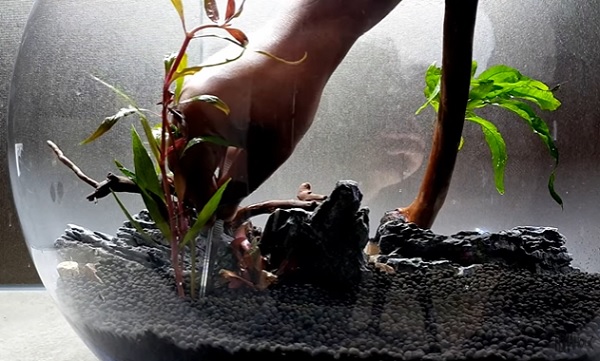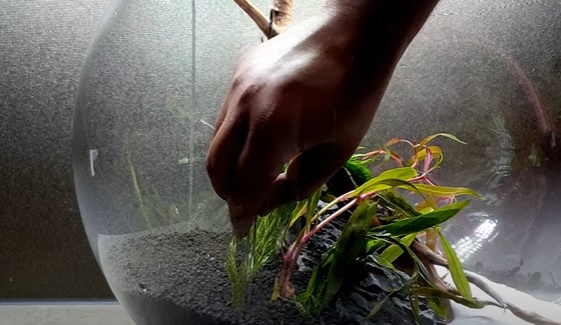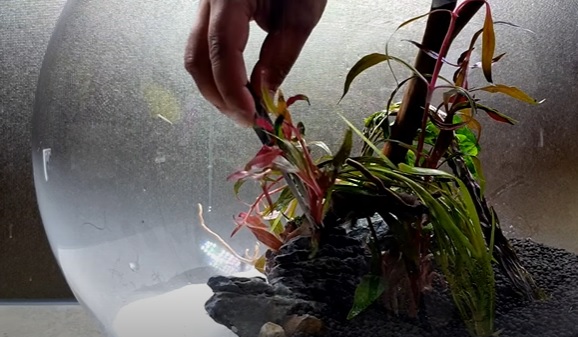Ideas for setting up a 15-gallon planted fish bowl aquarium with no filter:
Keeping aquatic plants in a fish
bowl aquarium is not difficult if the right plants are selected. Every aquatic
plant requires light, CO2 & nutrition for growth. If your tank lights are
low then select plants that do not need high lighting for example Anubias, Java
Fern, Java Moss etc. If you don’t want to inject CO2 then select plants that
have low CO2 needs. Fish releases carbon dioxide which is required by the
plant. In the presence of light, plants absorb carbon dioxide which helps in
photosynthesis.
Plants have different
requirements for plantation. Some of them need substrate while others should be
planted in a pot. Plants can be attached to the driftwood, rocks etc. Floating
plants do not need any type of support because they float freely on the water
surface.
If you are looking to set up a planted fish tank or interested in making a low maintenance aquatic bowl tank then in this video you will get an idea of making a low maintenance bowl tank that holds 15 gallons of water.
Watch below video which shows how to setup a 15 gallon fish bowl aquarium:
I am using two different
substrates for this fish bowl (sand & aquarium sol) & I am keeping
Seiryu rocks in the middle of the bowl. Check out info. about which midground
& background aquatic plants you can choose for your bowl.
Aquarium Substrate:
I have added AquaEarth aquarium
soil in the background of the bowl & White aquarium sand in the foreground.
I have put Seiryu aquarium rocks in the middle of the bowl that separate both
substrates. Small rocks are used for filling all gaps in the large Seiryu
rocks. They will prevent substrates from mixing.
Aquaearth:
It is a very fertile substrate
that helps in the growth of aquarium plants, controls the water hardness &
provides the best bed for aquatic plants. You can use it alone or add AquaLat
as a bottom layer for more nutrition.
White Aquarium Sand:
White aquarium sand can imitate a
beautiful natural habitat. It increases the production of good bacteria that
convert ammonia released from fish waste into less toxic forms. It can be used
for lowering the toxic debris present in the aquarium water.
Anubias:
Anubias has lush green arrow
shaped foliage. Add driftwoods in the middle of the bowl. Use aquarium safe
glue to stick Anubias plant to the driftwood.
Read: Which glues are safe for aquariums
They grow in a large variety of
substrates & gravels or can be attached to rocks, driftwood, or
decorations. Even though tank substrate is enough but you can plant it in
substrate containing high nutrition for better growth.
Java Fern:
Java Fern sends out shoots from
its nodes. Anchor Java Fern to the driftwood. Gently add glue to the rhizome of
the plant. Avoid putting glues on the roots because they absorb nutrients from
the water.
It seems delicate but enhances
the appearance of your tank. Many aquarists keep this plant in aquariums
because it grows slowly, have a distinct appearance, can be easily propagated,
& needs low care & maintenance. It is compatible with a variety of fish
& can live in harsh conditions.
Alternanthera Reinecki (Mini):
It is a compact appealing plant
that grows red leaves. I have added it to the midground of the aquarium.
It is a mini version of a popular
aquatic plant: Alternanthera Reinecki. It has a beautiful red color. The small
size of the plant makes it suitable for big & mini tanks. It is a hardy
plant. Many new aquarists keep this plant with no problem.
Alternanthera Reinecki:
Alternanthera Reinecki is a long-stalked
plant with red / violet colors. Alternanthera Reinecki plants have been added
to the back of its mini version.
It needs medium to high lights.
If tank lights are set to low then the lower leaves of the plant might fall
off. It is a best practice to divide each stem of the plant & plant them
individually. It can help the plant grow well & the lower leaves will still
get light as the plant gains height.
Vallisneria:
Vallisneria is a tall rosette
type plant. Vallisneria has been added to the back of Alternanthera Reinecki.
It is very simple to plant
Vallisneria. You only need to plant a collection of this plant in the back
corner of your aquarium & then it will spread on its own. It is a beautiful
long leaved plant, & fish love to hide in it.
Filigree Milfoil:
Filigree Milfoil has Green
Bristles type leaves. Filigree Milfoil has been added to the midground of the
fish bowl.
Filigree Milfoil needs low light
but for best results, you should keep it in moderate light. Do not plant the
stems very close to each other because the lower leaves could die. However,
they can be reproduced by trimming the top half of the plant stem &
replanting it in the substrate.
Rotala Rotundifolia:
Rotala Rotundifolia produces red
leaves in bright lights. Rotala Rotundifolia is added to the background of the
fish bowl.
Rotala Rotundifolia is a
fast-growing plant. It is very easy to propagate stem plants because you only
need to cut the tall stem of the plant & then replant it in substrate.
Fast-growing plants are good for reproduction & you can fill up your whole
tank from a single plant by trimming & replanting its stem.
Ludwigia Red:
Ludwigia Red produces red leaves
(topside & underside). Ludwigia red is added to the midground of the fish
bowl.
It is a beautiful red aquatic
plant that grows fast in enough light. It is a great addition to any tank
environment. It does not need high fertilizers so if you have fish in your bowl
then their wastes are enough to feed this plant.
Amazon Sword:
Amazon Sword has pale to dark
green lance shaped leaves. Amazon Sword is added to the background of the fish
bowl.
It is one of the best selections
for community aquariums. When buying Amazon Sword, find the one with long green
leaves. Do not buy plants with holes, cracks or brown spots. Choose the one
that seems healthy & has a robust root. Also avoid plants if its leaves are
faded or dying.
Final Step:
Fish bowl aquarium setup
completes. I have filled the bowl with water.
Plants need hydration. Fill a spray bottle with water & keep hydrating your plants from time to time while planting them in the fish bowl.











Post a Comment